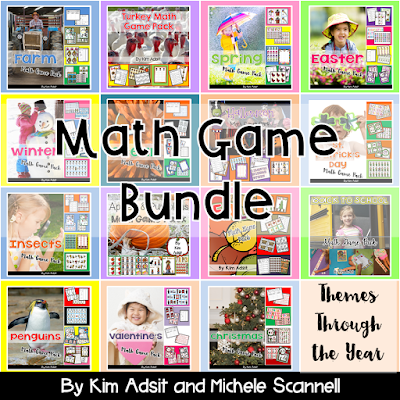We wanted activities that our kids could do independently with the counting bears. We started with a mini lesson. The minilessons help our kids gain independence through scaffolding. The mini lessons follow this format: demonstrate (I do), students to try it on their own with our support (We do) and try it on their own (You do). By providing this scaffold for our kids, they gain the support they need in order to be more successful when they are working independently. After you teach the lessons and you feel your students are ready to work independently, place all the materials, the “I can” chart, and the recording sheets with the counting bears.
Here is one of our favorite counting bear activities for teaching the measurement standards.
Collect several clip art images of things they are great for measuring length....pencil, key, marker, etc.
Invite kids to measure two different images using the bears.
Count how many bears it takes to measure each item.
Compare.
Recording pages are always optional. I usually use them for "have to" centers, but not for "can do" centers.
On the recording page, the kids write the numeral to represent how many bears it took to measure each item.
Then, they circle which item is longer or shorter.
Here is one of our favorite counting bear activities for teaching the counting standards.
Invite the children to spin the numeral spinner and the color spinner.
Count the number/color of bears to match the spinners.
Put the bears on the grid.
Spin again. Continue to spin until the grid is full.
Once the grid is full, invite the children to sort and count the bears.
Record the number of each color of bear on the grid.
Here is one of our favorite counting bear activities for teaching the shapes standards.
Invite the children to spin the spinner.
Select a counting bear to cover that shape on the game board.
Spin again.
Continue to spin until the game board is full!
Here is one of our favorite counting bear activities for teaching the addition & subtraction standards.
Invite the children to select a cards (1-5).
Count bears to match the numeral, and place them on the fives frame.
Use a second color of bear to fill in the remaining squares.
The children color the fives frame on the recording page to match the bears on the fives frame.
Record the number sentence.
You can also play this game on a tens frame.
Here is one of our favorite counting bear activities for teaching the composing and decomposing standards.
Give the child a double tens frame.
Invite them to put 10 bears, one color, to fill up the first tens frame.
Now, grab a handful of a different color of bear.
Add those bears to the second tens frame.
Color the tens frames on the record sheet and decompose the number!
Here is one of our favorite counting bear activities for teaching the data standards.
Invite the children to make a pattern using the counting bears. (Cut the strips long enough so that there won't be more bears than can fit on the graph!)
Once the pattern is made, move the bears to the graph.
Record the graph on the recording paper.
Analyze the data.
Simple is Best!
We made these games SIMPLE! We want our kids to be able to play these activities totally by themselves! You might have noticed that the games are similar to some of the ones in our pattern blocks, linking cubes, and colored tiles units. We change the manipulative and play the same or similar games! This makes kids very independent and successful!
These activities are a sample of the activities in the Counting Bears Unit.
You can watch a video preview of all of the activities from this unit here.


































































































